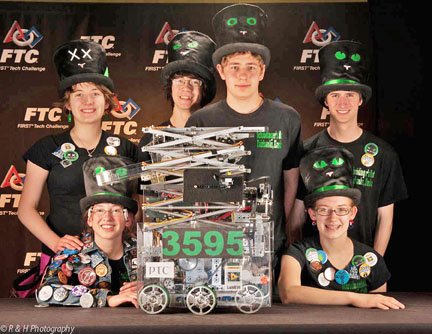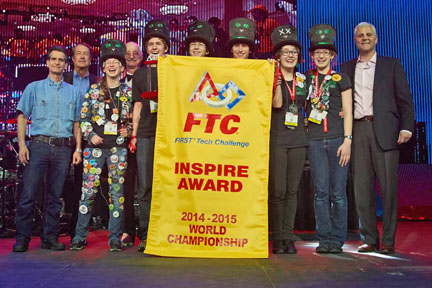Our favorite organization, FIRST (For inspiration and Recognition of Science and Technology) works with kids from grade school through high school. The Junior FIRST LEGO League is for children ages 6 – 9, the FIRST LEGO League grades 4 – 8, The FIRST Tech Challenge grades 7 – 12, and the FIRST Robotics Competition grades 9 – 12. You can get involved in your city. Check it out at www.usfirst.org/community/volunteers.
FIRST Tech Challenge (FTC) World Championship was held recently in St Louis. FTC students learn to think like engineers. Teams build robots from a reusable kit of parts, develop strategies, document their progress, and compete head to head. FIRST Tech Challenge team 3595, Schrödinger's Hat, won the Inspire Award this year. The team is from Fairbanks, Alaska.
This year's game challenge focused around collecting wiffle balls (both golf ball and baseball sized), and placing them into rolling goals of different heights. The game was played on a 12 x 12-ft. field, with four robots on the field at a time. Three rolling goals (30 cm, 60 cm, and 90 cm height) were on the field for each team and here was a 120 cm tall “center goal.” Robots are programmed for a 30-second autonomous period and then are driver-controlled for the final two minutes of the match.
All robots must start out within an 18-in. cube. The Schrödinger's Hat robot expanded to over 5 ft. tall. It weighed approximately 60 pounds. The robot has a zip-tie brush that picks up both sizes of balls and pushes them up onto a “flicker” mechanism — a piece of spring steel on two spring hinges that shoots the balls up into a hood. This hood was made by spot welding non-galvanized steel wire into a shape that redirects the balls downward into the rolling goal. They have a scissor lift to raise the hood mechanism so as to score in all different heights of goals.

Schrödinger's Hat team members: Colleen Johnson (in back), Emily Maynard, Andrew Parker, Eli Simmons, Katie Johnson (in front), Justin Hannah.
The robot's drive train has six wheels with six motors, and uses a redundant design, so even if a motor burns out or a chain falls off, the robot continues to drive. For accurate navigation it relies on a gyro sensor, an IR sensor, and an unpowered wheel attached to a rotation sensor. The team used an NXT controller for its robot and programmed it in LabVIEW. They used PTC Creo (from 3HTI) to model the robot design, and AndyMark NeveRest motors, HiTechnic servos, and LEGO NXT motors.

The team said their robot's continuous-scoring ability made it especially competitive. Its autonomous mode was quite accurate, reliably scoring over 100 points each match. The team used CAD in a lot of their design process, and kept a detailed engineering notebook to document the entire season. All six team members plan to study engineering or computer science.
Advertisement
Learn more about Electronic Products Magazine





